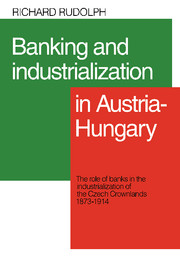 Banking and Industrialization in Austria-Hungary
Banking and Industrialization in Austria-Hungary Published online by Cambridge University Press: 05 January 2012
Several attempts have been made to construct national income accounts for Austria and Hungary prior to the First World War. The basic study is that of Friedrich von Fellner, published in 1917, which presents national income accounts on an average 1911–13 basis for Austria and Hungary. Fellner utilized official tax records as well as information provided him by individual manufacturers, and while some modifications have since been made of his work, it has remained the touchstone for discussions of the prewar Austrian economy. Ernst Waizner has made use of some of Fellner's private material to ascertain the contributions of the various regions of the monarchy to the income of the monarchy as a whole. Friedrich Hertz has modified Fellner's work to take into account the service sector, which Fellner ignores, and has made his own estimates of Austrian national income on an average 1902–3 basis to provide grounds for a study of change in the economy. The most recent study of long-term Austrian national income from 1913 to 1963, undertaken by the Austrian Institute for Economic Research, has used Fellner's data as modified by Hertz for its base-year data. Several minor alterations have been made to make the Fellner material conform to contemporary national income accounting techniques.
A composite index of industrial production has been constructed on the basis of five series. These series are made up of representative sub-series which encompass the major part of the following sectors: mining, metalmaking and metalworking, engineering, foodstuffs, and textiles.
To save this book to your Kindle, first ensure [email protected] is added to your Approved Personal Document E-mail List under your Personal Document Settings on the Manage Your Content and Devices page of your Amazon account. Then enter the ‘name’ part of your Kindle email address below. Find out more about saving to your Kindle.
Note you can select to save to either the @free.kindle.com or @kindle.com variations. ‘@free.kindle.com’ emails are free but can only be saved to your device when it is connected to wi-fi. ‘@kindle.com’ emails can be delivered even when you are not connected to wi-fi, but note that service fees apply.
Find out more about the Kindle Personal Document Service.
To save content items to your account, please confirm that you agree to abide by our usage policies. If this is the first time you use this feature, you will be asked to authorise Cambridge Core to connect with your account. Find out more about saving content to Dropbox.
To save content items to your account, please confirm that you agree to abide by our usage policies. If this is the first time you use this feature, you will be asked to authorise Cambridge Core to connect with your account. Find out more about saving content to Google Drive.